Ant control in Vancouver
We have you protected from carpenter, pavement, pharaoh, argentine and other common ants in Vancouver
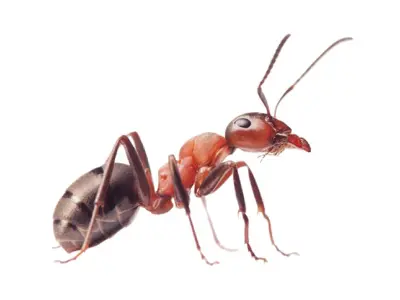
There are approximately 75 species of ants found in British Columbia. Some common ant species in the region include Argentine ants, pavement ants, carpenter ants, fire ants, and pharaoh ants. Each species has its own unique behaviour, nesting habits, and potential impact on properties, making it important to accurately identify the type of ant infestation for effective control and prevention strategies.
Unfortunately, the majority of DIY pest treatments merely eradicate the visible ants; in fact, hundreds more may be on their way. A professional pest control service is necessary to completely eradicate the infestation and stop ants from entering your house again.
How long it takes to eliminate an ant infestation?
Most indoor ant infestations can typically be resolved in one to two appointments. What sets us apart is our use of diverse treatment methods, unlike many other companies that rely on a single approach.
Eliminating ants effectively requires a combination of treatments. Baiting systems, including gel, granular, and liquid baits, lure ants to carry poison back to the colony. Residual insecticides, such as non-repellent sprays, dusts, and perimeter treatments, target ants at their source.
Dealing with Carpenter Ants? Evict Them for Good!
Most indoor ant infestations can typically be resolved in one to two appointments. What sets us apart is our use of diverse treatment methods, unlike many other companies that rely on a single approach.
Eliminating ants effectively requires a combination of treatments. Baiting systems, including gel, granular, and liquid baits, lure ants to carry poison back to the colony. Residual insecticides, such as non-repellent sprays, dusts, and perimeter treatments, target ants at their source.
Common Ants We Treat
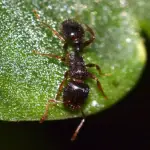
Pavement ants
The reason pavement ants receive their name is because they build their nests under or in cracks in pavement. Structures may also get infested by these dark brown to black ants.
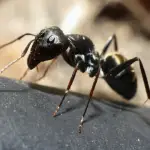
Carpenter ants
A carpenter ant is a large ant species known for excavating wood to create nests. Unlike termites, they do not consume wood but can cause structural damage. They are typically black or red and black, and can range in size from 1/4 to 1/2 inch. They are known for damaging wood structures.
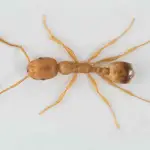
Pharaoh ants
The pharaoh ant is a small, yellow to light brown ant species known for its prolific nesting habits and difficulty to control. They are notorious indoor pests, forming extensive colonies in buildings and feeding on a variety of foods, including sweets, oils, and proteins.
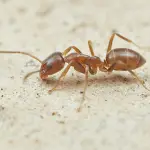
Argentine ants
The Argentine ant is a small, light to dark brown ant native to South America. Known for forming large colonies with multiple queens, these ants are highly invasive and can displace native ant species. They thrive in urban and agricultural areas, often entering homes in search of food.
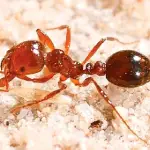
Red Imported Fire Ants
A fire ant is a small, reddish-brown insect known for its aggressive behavior and painful sting. Native to South America, these ants form large colonies and build noticeable mound nests. They are invasive pests in many regions, causing damage to crops, livestock, and posing health risks to humans and animals.
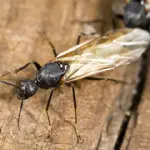
Winged ants
Did you know that winged ants are not a species? They are reproductive members of any ant colony, often seen during mating season, known as “nuptial flights.” They resemble flying termites but have pinched waists, bent antennae, and two differently sized wings. These flying ants can swarm in large numbers, particularly after rain, seeking new areas to establish colonies, which can lead to infestations indoors
Our Ant Control Process
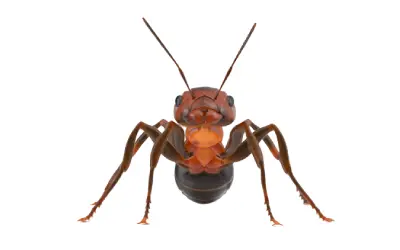
Inspection & Identification
The first step is to conduct a thorough inspection of your property to identify the source of the ant infestation and determine the extent of the problem. Once the type of ant species is determined, technicians can tailor their treatment plan to target the specific behaviors and preferences of that species.
Targeted Treatment
Technicians will implement targeted treatments that may include the application of insecticides in key areas where ants are likely to nest or travel, such as along baseboards, in cracks and crevices, and near entry points.
Follow-Up & Prevention
Sealing entry points and providing long-term solutions. A 1st pest Control technician will offer recommendations to help prevent future ant infestations, such as sealing cracks and crevices, reducing food and water sources, and maintaining proper sanitation practices.
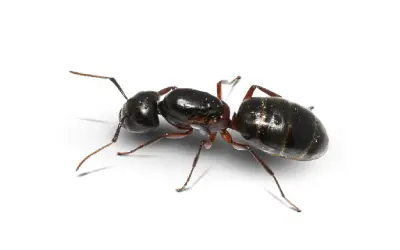
Why Choose 1st Pest Control for Ant Removal?
Experienced Professionals:
Our team specializes in bed bug control and uses proven methods for eradication.
Safe & Effective Solutions:
We use safe and pet-friendly insecticides that work efficiently against all species of ants.
Comprehensive Service:
From inspection to treatment and follow-up, we ensure an ant-free home.

New to 1st Pest Control?
Enjoy 10% OFF your first treatment service.
Enter Code NEW10 in the contact form

Ready to Rid Your Home of Pests? Contact 1st Pest Control Now for Expert Treatments.
We help remove pests and wildlife, and help prevent them from coming back! - Fast and efficiently
FAQs - Ants
What do they look like?
Ants have exoskeletons surrounding their elongated bodies and narrow waists. They also have elbowed antennae, three pairs of legs, and a prominent head endowed with a strong jaw used to forage, construct, and defend. Ants come in various shades of black, brown and red.
On average, ants can grow up to an inch long, though are commonly observed to be less than half that length. Ants are social insects and live in small to significantly large colonies containing one or several queens.
The queens and male ants have wings, whereas worker female ants do not. Common ant species encountered in the locality are pavement ants, carpenter ants and Pharaoh ants.
Where do they come from?
Ants may enter a residence in search of new areas to construct a nest or to forage for food. Ants are omnivorous with a diet that generally consists of insects, sugary products, and other food types consumed by humans.
They enter a residence through small cracks and crevices with openings leading from the outside, as well as larger entry points such as gaps along windows and doors. Their small size allows them to easily move across spaces between and within residences.
Can they cause any damage to my property?
Ants form small to large colonies that may become hazardous depending on their location. Some ants construct their nests inside wooden structures such as walls and floors. As they continue to break down wood to expand the size of their nest, these structures begin to weaken and may collapse. Ants are also known to nest under pavements, under or in close proximity to structural foundations, in the soil or trees.
Their large population size and constant construction of nests may result in costly damages to property.
Can they cause me or my family to become sick?
Ants are generally considered a low health risk. However, it is not impossible for them to spread contamination by picking up pathogens as they travel from place to place. Fire ants are found in the Vancouver area and can deliver painful venomous stings.
Typical symptoms include pain, redness and swelling. Though rarely fatal, their sting may cause allergic reactions in some individuals.
Where would I find them in my house?
Small groups of foraging ants are typical indicators of a nearby nest. They can be found indoors within a building’s structure including the walls, floors or foundation. Alternatively, they may have constructed a nest outdoors in close proximity to the building, such as beneath the ground or inside trees.
Subsurface ant activity located outdoors are commonly identified by ant hills, or soils pushed up as a result of their underground construction.
Why do I have to get rid of them?
Ants are primarily a nuisance pest that construct and expand their nests, both indoors and outdoors. Their indoor nesting activities might weaken a building’s structural integrity resulting in an unsafe living or working environment.
With an increase in ant population and the longer a nest is occupied, damages caused by ants could become very costly to fix or replace. An ant infestation may become a health hazard with increased risk for venomous stings and contamination.


